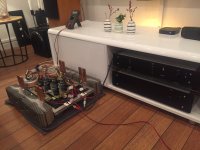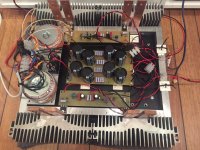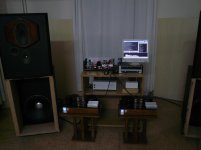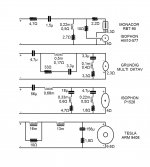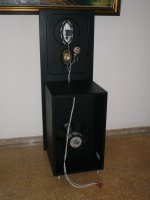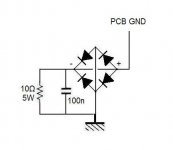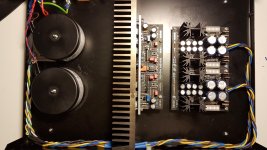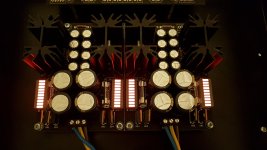Hey guy's...
Finally i got my classA put together in yet another betabuild http://www.diyaudio.com/forums/pass-labs/301312-alephj-mimi-mini.html
http://www.diyaudio.com/forums/pass-labs/301312-alephj-mimi-mini.html
-Listning to Sala's pre. throught SE ClassA (Real ClassA ) for +5 hour's today; it is so good. Every detail comes through wire's now, at both low and high listening level!
) for +5 hour's today; it is so good. Every detail comes through wire's now, at both low and high listening level!
--Setup beats my LM4780 cloneamp.; eventhrough it's also good.
I tried comparing it with my B1 unitygain pre.; and the difference is clear DCG3 wins, -But ofcause i cannot tell if it's the dual psu or the gain which makes this much difference? -Also it could be that i am a little proud still to have done this build? (I belive that music need some preamp. gain, but this is rather religius i think ) -Anyway it's good.
) -Anyway it's good.
Daughter at 17 also had a little WOW , and i told her to put her young ears, with high volume with music on pause, for discovering noise! -It's clearly noiseless father she said
, and i told her to put her young ears, with high volume with music on pause, for discovering noise! -It's clearly noiseless father she said  ... So good.
... So good.
Hoping not to offtopic, but i just want to share my finding with different amp's.
Jesper.
Finally i got my classA put together in yet another betabuild
-Listning to Sala's pre. throught SE ClassA (Real ClassA
--Setup beats my LM4780 cloneamp.; eventhrough it's also good.
I tried comparing it with my B1 unitygain pre.; and the difference is clear DCG3 wins, -But ofcause i cannot tell if it's the dual psu or the gain which makes this much difference? -Also it could be that i am a little proud still to have done this build? (I belive that music need some preamp. gain, but this is rather religius i think
Daughter at 17 also had a little WOW
 , and i told her to put her young ears, with high volume with music on pause, for discovering noise! -It's clearly noiseless father she said
, and i told her to put her young ears, with high volume with music on pause, for discovering noise! -It's clearly noiseless father she said Hoping not to offtopic, but i just want to share my finding with different amp's.
Jesper.
Attachments
I' m back to report after a weekend dedicated to my hobby!
Before anything, some basics have to be said. My system is completely diy. There is not any reference gear in it. And I do not own any measurment equipment as well. Plus, I' m not an EE. I' ll only describe relative defferences to the sound I' m used to with my current high gain differential tube preamp with full dual psu.
One thing for sure is that dcg3 came to stay! Salas, your design is great both for functionality and musicality. OK, I had achieved a very wide soundstage but know there is more authority to the instruments placed at the edges. It doesn't lose anything inside the stage but it doesn't pronounce anything either. I like this very much. I strive for properly orientaded soundstage while I can easily disregard nuances and timbre. Also although I was used to very fast and clear bass, dcg3 does faster. It has better grip in low frequencies. For midrange, first impression was that it runs out of headroom at some point but suddent slams made me realize that this is not the case. I come to think that I' m addicted to some intermodulation distortion. Taming IMD without bench stuff became an obsession. I spent the whole last year converting my full SE system to full balanced not because any noise issues but to take advantage of distortion cancelation of diff amps. In particular I was attracted by the theoritical constant load behaviour of these amps. I thought it as a way to minimize the interaction between the gain circuit and the psu. I had great improvement but also I earned experience that helps me understand what a very good psu is the dcstb. I' m planing to do a test with my dcg3 in SE mode with one phase fed with positive signal and the other at idle vs fed with negative signal vs fed with positive signal floated at all times. I have to confess that this is the reason I ordered two modules. Dcg3 should do in SE mode all things I was looking for in tube diff amps. My usuall novice way to understand electronics!
Another thing is that I don't get balanced signal at the output whith SE input and the negative phase grounded. To my understanding this was expected. For this to work a common current sink must be shared between the two phases. If it was about tubes I would say that J3(bf256b) should be common for the upa68h of both channels but this is solid state thus far beyond my knowledge... I took a look at ba-3 schem and I think it follows the same principal. Trying to explain this I would like to ask Nash what kind of psu feeds the ba-3. If it is mono cofiguration and high impedance then it could be that one phase modulates the other through the psu, otherwise hands up! Anyway, this feature is only usefull when conversion of SE input to bal output is required and I don't need it. Because I use an audio PC ground lifters were inserted in my previous set up to address hum and I did the same now. With my wiring schem, the ground lifters are not mandatory for XLR in/XLR out but they don't hurt either. They are necessary in SE mode which only works with RCA in/RCA out. XLR in /RCA out means hum and RCA in/XLR out is meaningless as mentioned above. XLRs pin 1 could be connected either to chassis or to pcb ground but I left it to chassis so that it' ll be compartible with the rest of my gear.
Anyway, this feature is only usefull when conversion of SE input to bal output is required and I don't need it. Because I use an audio PC ground lifters were inserted in my previous set up to address hum and I did the same now. With my wiring schem, the ground lifters are not mandatory for XLR in/XLR out but they don't hurt either. They are necessary in SE mode which only works with RCA in/RCA out. XLR in /RCA out means hum and RCA in/XLR out is meaningless as mentioned above. XLRs pin 1 could be connected either to chassis or to pcb ground but I left it to chassis so that it' ll be compartible with the rest of my gear.
Listening to dcg3 I think it sat very comfortably in my system. No noise issues in any configuration. Please keep in mind that there is not any kind of attenuator in the chain from the DAC output down to amps OTPs. Well, actually the very low - 2 ohms - I/V resistor of the DAC improves SNR significantly but that's all! For volume control I use the DAC's "hardware" which happily stays above halfway all the time. Honestly I don't feel like changing anything but I' m interested to any suggestions.
Kostas
Before anything, some basics have to be said. My system is completely diy. There is not any reference gear in it. And I do not own any measurment equipment as well. Plus, I' m not an EE. I' ll only describe relative defferences to the sound I' m used to with my current high gain differential tube preamp with full dual psu.
One thing for sure is that dcg3 came to stay! Salas, your design is great both for functionality and musicality. OK, I had achieved a very wide soundstage but know there is more authority to the instruments placed at the edges. It doesn't lose anything inside the stage but it doesn't pronounce anything either. I like this very much. I strive for properly orientaded soundstage while I can easily disregard nuances and timbre. Also although I was used to very fast and clear bass, dcg3 does faster. It has better grip in low frequencies. For midrange, first impression was that it runs out of headroom at some point but suddent slams made me realize that this is not the case. I come to think that I' m addicted to some intermodulation distortion. Taming IMD without bench stuff became an obsession. I spent the whole last year converting my full SE system to full balanced not because any noise issues but to take advantage of distortion cancelation of diff amps. In particular I was attracted by the theoritical constant load behaviour of these amps. I thought it as a way to minimize the interaction between the gain circuit and the psu. I had great improvement but also I earned experience that helps me understand what a very good psu is the dcstb. I' m planing to do a test with my dcg3 in SE mode with one phase fed with positive signal and the other at idle vs fed with negative signal vs fed with positive signal floated at all times. I have to confess that this is the reason I ordered two modules. Dcg3 should do in SE mode all things I was looking for in tube diff amps. My usuall novice way to understand electronics!
Another thing is that I don't get balanced signal at the output whith SE input and the negative phase grounded. To my understanding this was expected. For this to work a common current sink must be shared between the two phases. If it was about tubes I would say that J3(bf256b) should be common for the upa68h of both channels but this is solid state thus far beyond my knowledge... I took a look at ba-3 schem and I think it follows the same principal. Trying to explain this I would like to ask Nash what kind of psu feeds the ba-3. If it is mono cofiguration and high impedance then it could be that one phase modulates the other through the psu, otherwise hands up!
 Anyway, this feature is only usefull when conversion of SE input to bal output is required and I don't need it. Because I use an audio PC ground lifters were inserted in my previous set up to address hum and I did the same now. With my wiring schem, the ground lifters are not mandatory for XLR in/XLR out but they don't hurt either. They are necessary in SE mode which only works with RCA in/RCA out. XLR in /RCA out means hum and RCA in/XLR out is meaningless as mentioned above. XLRs pin 1 could be connected either to chassis or to pcb ground but I left it to chassis so that it' ll be compartible with the rest of my gear.
Anyway, this feature is only usefull when conversion of SE input to bal output is required and I don't need it. Because I use an audio PC ground lifters were inserted in my previous set up to address hum and I did the same now. With my wiring schem, the ground lifters are not mandatory for XLR in/XLR out but they don't hurt either. They are necessary in SE mode which only works with RCA in/RCA out. XLR in /RCA out means hum and RCA in/XLR out is meaningless as mentioned above. XLRs pin 1 could be connected either to chassis or to pcb ground but I left it to chassis so that it' ll be compartible with the rest of my gear. Listening to dcg3 I think it sat very comfortably in my system. No noise issues in any configuration. Please keep in mind that there is not any kind of attenuator in the chain from the DAC output down to amps OTPs. Well, actually the very low - 2 ohms - I/V resistor of the DAC improves SNR significantly but that's all! For volume control I use the DAC's "hardware" which happily stays above halfway all the time. Honestly I don't feel like changing anything but I' m interested to any suggestions.
Kostas
Attachments
Last edited:
Interesting high sensitivity speakers. Are those NOS German oval FR drivers at the top cabinets? Like SABA?
From what you describe it seems like your doubled up balanced DCG3 configuration works without a practical problem, plus subjectively you are happy with some noticeable added realism over your previous symmetrical tubes preamp solution. Congratulations for your build then. In case you will feel like needing 3dB more gain or something like that in the concept of your source and system, its feasible with R6 value change of course.
From what you describe it seems like your doubled up balanced DCG3 configuration works without a practical problem, plus subjectively you are happy with some noticeable added realism over your previous symmetrical tubes preamp solution. Congratulations for your build then. In case you will feel like needing 3dB more gain or something like that in the concept of your source and system, its feasible with R6 value change of course.
Interesting high sensitivity speakers. Are those NOS German oval FR drivers at the top cabinets? Like SABA?
From what you describe it seems like your doubled up balanced DCG3 configuration works without a practical problem, plus subjectively you are happy with some noticeable added realism over your previous symmetrical tubes preamp solution. Congratulations for your build then. In case you will feel like needing 3dB more gain or something like that in the concept of your source and system, its feasible with R6 value change of course.
Speakers started as the infamus Lampizator Endorfine project but now there is almost nothing common with the original design. The big oval and the little round are vintage alnico isophons. The small oval is grundig. Woofers are mighty 15" tesla. I need to finish them. DCG3 ate the funds for the Jantzen coils but I don't regret it! I have the chance to give them a final fine tune with my new gear
Yes, I' m very pleased with the way DCG3 matched the rest of the system. I' ll give a round as a dedicated headphone amp after my tube preamp just to hear my AKG cans but mainly it will serve as line stage. Actually I wouldn't even call it line stage. It is the analogue output of my DAC and it does it excellent!
Attachments
Yes, speakers are the only components that I can measure! I have installed ARTA in my audio PC so speakers measurment actually are used to match them with the particular system in the particular room. I can't tell if they would measure- sound the same in another system.
I' m about to finish them and then I' ll present them in the speakers forum for anyone that would be interested.
I' m about to finish them and then I' ll present them in the speakers forum for anyone that would be interested.
I rushed to catch up your request but I can't find the usb flash with some measurments. Anyway they where preliminary tests. Soon I' ll have finals. Moving the teslas into H frames with baffle step compensators in the XO did very good to the bass! 94db down to 40Hz. But these are 15" drivers. Roll off below 40Hz is not heard as it measures! The interesting thing is what happens above 40Hz. I managed to get rid of an ungly comb effect that gave a very nice resolution at low frequencies. Of course, don't expect the ideal flat FR of your speakers. I mostly focus on step response and minimum phase plots. This is the central principal of this project: big, lightweight, time aligned paper cones. One can percieve this from the first note - I think.
The little monacor is mounted at the dark side! I thought to test full dipole function all the way but I wasn't sure how it would sound. The magnetostatic driver has a flat impedance just like a resistor and it was easily inserted into the isophon tweeter's XO as attenuator. Fortunatelly the monacor itself sat on the right SPL. No further alignment was done for this. I just put it there and had a trial and error test simply by masking it with a piece af paper that didn't change the XO properties. According to my taste it stayed on
Attachments
Another thing is that I don't get balanced signal at the output whith SE input and the negative phase grounded. To my understanding this was expected. For this to work a common current sink must be shared between the two phases. If it was about tubes I would say that J3(bf256b) should be common for the upa68h of both channels but this is solid state thus far beyond my knowledge... I took a look at ba-3 schem and I think it follows the same principal. Trying to explain this I would like to ask Nash what kind of psu feeds the ba-3. If it is mono cofiguration and high impedance then it could be that one phase modulates the other through the psu, otherwise hands up!Anyway, this feature is only usefull when conversion of SE input to bal output is required and I don't need it. Because I use an audio PC ground lifters were inserted in my previous set up to address hum and I did the same now. With my wiring schem, the ground lifters are not mandatory for XLR in/XLR out but they don't hurt either. They are necessary in SE mode which only works with RCA in/RCA out. XLR in /RCA out means hum and RCA in/XLR out is meaningless as mentioned above. XLRs pin 1 could be connected either to chassis or to pcb ground but I left it to chassis so that it' ll be compartible with the rest of my gear.
Kostas
Kostas, good to hear your comments. I am down with the flu so my build is on hold.
Tell me about your ground lifters. Diode? Resistor?
My Ba3 bal is fed by hotrodded Salas SLV1.1 BIB regs. + and - regs for each channel.
Nash, I wish you quick recovery! Ground lifters are from Rod Elliot's website. As for the BA3, it seems to be different than DCG3. I don't have the knowledge to explain it...Psu is definately OK.
Not very sure whether you are using only a bridge. Is it an open between the DCG3 PCB ground and the chassis connection or do you measure a resistance? I think your issue may lie here.
Schematic attached. It measures 10 ohms DCR from PCB ground to chassis.Not very sure whether you are using only a bridge. Is it an open between the DCG3 PCB ground and the chassis connection or do you measure a resistance? I think your issue may lie here.
Attachments
Started assembling a bit more. Think I will have sound in a week or so 
Measuring PSU with no load:
Left: Right:
17.374 Vdc 17.201 Vdc
-17.120 Vdc -17.212 Vdc
The chassis is in fact from a good integrated amp. Holfi Integra 8AE..
Measuring PSU with no load:
Left: Right:
17.374 Vdc 17.201 Vdc
-17.120 Vdc -17.212 Vdc
The chassis is in fact from a good integrated amp. Holfi Integra 8AE..
Attachments
Last edited:
Schematic attached. It measures 10 ohms DCR from PCB ground to chassis.
OK. From what I understand for SE to work, signal reference must be connected to the PCB ground. In my BA3 the RCA signal reference is connected to XLR1 which is connected to PCB ground, not to chassis like you have it. So t o be clear I have + of RCA to +phase of PCB, signal reference of RCA to PCB ground and also a connection from PCB ground to - phase of PCB. I too like you have a 10R CL60 from the PCB ground to chassis ground.
Hope this works for you.
nash
Does this mean that BA3 PCB has +phase/GND/-phase inputs or is it two indepented boards with hot and ground one used for positive and the other for negative phase? Could you post a diagram of your circuit?...and also a connection from PCB ground to - phase of PCB.
nash
Started assembling a bit more. Think I will have sound in a week or so
Measuring PSU with no load:
Left: Right:
17.374 Vdc 17.201 Vdc
-17.120 Vdc -17.212 Vdc
The chassis is in fact from a good integrated amp. Holfi Integra 8AE..
Looks alright for DC. I remember Holfi from some older hi-fi shows here. They had wooden fascia.
- Home
- Source & Line
- Analog Line Level
- Salas DCG3 preamp (line & headphone)
